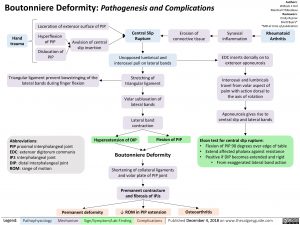Boutonniere Deformity: Pathogenesis and Complications Laceration of extensor surface of PIP
Authors: William F Hill Marshall Thibedeau Reviewers: Emily Ryznar Brett Byers* *MD at time of publication
Rheumatoid Arthritis
Hand trauma
Hyperflexion of PIP
Dislocation of PIP
Central Slip Rupture
Unopposed lumbrical and interossei pull on lateral bands
Stretching of triangular ligament
Volar subluxation of lateral bands
Lateral band contraction
Hyperextension of DIP
Erosion of connective tissue
Synovial inflammation
Avulsion of central slip insertion
Triangular ligament prevent bowstringing of the lateral bands during finger flexion
EDC inserts dorsally on to extensor aponeurosis
Interossei and lumbricals travel from volar aspect of palm with action dorsal to the axis of rotation
Aponeurosis gives rise to central slip and lateral bands
Elson test for central slip rupture:
• Flexion of PIP 90 degrees over edge of table • Extend affected phalanx against resistance • Positive if DIP becomes extended and rigid
• From exaggerated lateral band action
Abbreviations:
PIP proximal interphalangeal joint EDC: extensor digitorum communis IPJ: interphalangeal joint
DIP: distal interphalangeal joint ROM: range of motion
Flexion of PIP
Boutonniere Deformity
Shortening of collateral ligaments and volar plate of PIP joint
Premanent contracture and fibrosis of IPJs
Permanent deformity
↓ ROM in PIP extension
Osteoarthritis
Legend:
Pathophysiology
Mechanism
Sign/Symptom/Lab Finding
Complications
Published December 4, 2018 on www.thecalgaryguide.com
Foundations
Systems
Other Languages
Orthopedics Hand Boutonniere Deformity: Pathogenesis and Complications Boutonniere Deformity: Pathogenesis and Complications

